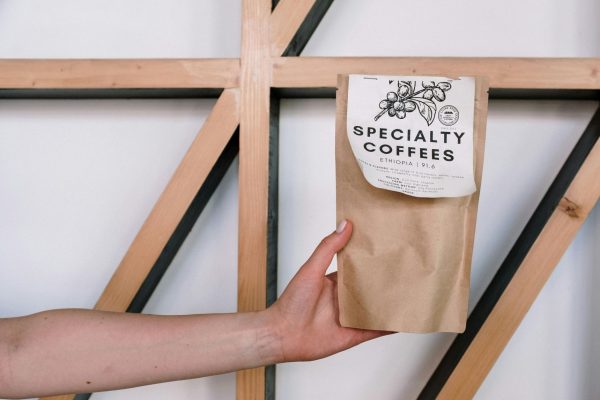
Your coffee bag descriptions are powerful sales tools that can differentiate your products, justify pricing, and connect customers to your brand story. Whether you prefer minimalist messaging or detailed storytelling, the key is understanding your target customer and executing your chosen approach effectively. There’s no single “right” way to describe coffee, only approaches that work better or worse for your specific market, brand positioning, and business goals.
Understanding Your Options: What Information Can You Include?
The good news is that you have access to far more information than you might realize. Most green coffee suppliers can provide detailed producer information, processing specifics, farm details, and origin stories for virtually any coffee you purchase. The question isn’t what information is available, but what information serves your customers and business best.
Foundation Elements:
- Origin (country/region)
- Roast level
- Primary tasting notes
- Processing method
Enhanced Storytelling Options:
- Producer names and stories
- Farm altitude and growing conditions
- Specific varietals and their characteristics
- Detailed processing methods and fermentation
- Cooperative information and community impact
- Harvest and milling details
- Direct trade relationships
- Sustainability practices and certifications
Premium Positioning Elements:
- Micro-lot designations
- Competition scores or awards
- Exclusive relationships or limited availability
- Unique processing experiments
- Producer collaboration stories
Choosing Your Approach: Know Your Target Customer
The right description strategy depends entirely on who you’re trying to reach and what motivates their purchasing decisions.
The Minimalist Approach
Best For: Busy customers, high-traffic locations, price-conscious buyers, broad appeal
Customer Motivation: Convenience, reliability, clear expectations
Execution: Clean, simple language focusing on taste and roast level
Example: “Guatemala Antigua – Medium Roast. Chocolate and caramel with bright citrus. Balanced and approachable.”
Advantages: Easy to read quickly, broad appeal, lower training requirements for staff
Requirements: Consistent quality, competitive pricing, efficient service
The Educational Approach
Best For: Coffee enthusiasts, specialty shops, customers who value learning
Customer Motivation: Knowledge, exploration, understanding coffee diversity
Execution: Moderate detail with accessible explanations
Example: “Guatemala Huehuetenango – Washed Process. Grown at 1,600m by the Asociación Barillense cooperative. Bright apple acidity with milk chocolate body and honey sweetness. The high altitude and volcanic soil create exceptional clarity and complexity.”
Advantages: Builds customer knowledge, supports premium pricing, creates conversation opportunities
Requirements: Staff training on processing and regions, consistent sourcing, educational marketing
The Storytelling Approach
Best For: Premium positioning, coffee connoisseurs, experience-focused customers
Customer Motivation: Connection, exclusivity, supporting specific producers
Execution: Detailed narratives that create emotional connection
Example: “Don Elias Micro-lot – Natural Process. This exceptional coffee comes from Elias Ramos, a third-generation producer in Nariño, Colombia, who has spent decades perfecting his natural processing method. Grown at 2,100 meters on just 2 hectares, this limited lot showcases intense berry flavors with wine-like complexity and chocolate undertones. Only 15 bags available.”
Advantages: Premium pricing, creating customer loyalty, differentiating from competitors
Requirements: Deep product knowledge from staff, consistent high-quality sourcing, premium packaging and presentation
Executing Your Chosen Strategy
Regardless of which approach you choose, successful execution requires alignment across several areas.
Staff Knowledge and Training
Whatever level of detail you put on your bags, your staff should be able to discuss and expand upon that information confidently. If you include producer stories, train your team on those stories. If you mention processing methods, ensure they understand how those methods affect flavor.
Sourcing Consistency
Your descriptions create customer expectations that your coffee needs to meet consistently. Work closely with your green coffee supplier to understand what information is available and how reliable that quality and availability will be over time.
Visual Identity Alignment
Your packaging design should support your description strategy. Premium micro-lot stories deserve premium packaging design. Simple, accessible descriptions work well with clean, straightforward branding. The visual presentation should reinforce the story your descriptions tell.
Leveraging Your Supplier Relationship
Your green coffee supplier is a crucial partner in creating compelling descriptions. Most importers have extensive information about the coffees they offer.
What You Can Request:
- Detailed producer profiles and farm information
- Processing specifics and quality scores
- Harvest dates and seasonal availability
- Certification documentation and compliance
- Unique story elements that differentiate each coffee
- Photos of farms, producers, or processing
Building Information Partnerships
At ICT, we work with roasters to provide exactly the level of detail that matches their description strategy. Whether you need basic origin information or comprehensive producer stories, we can supply the background information that makes your descriptions accurate, compelling, and sustainable over time. We understand that great coffee descriptions start with great information about the coffee itself.
Strategic Considerations for Long-term Success
Pricing and Positioning
Your description strategy should support your pricing structure. Detailed stories and premium positioning require premium execution and can justify higher prices. Simple, accessible descriptions work well for competitive pricing strategies.
Scalability
Consider how your description approach will scale as your business grows. Detailed storytelling requires more staff training and product knowledge management than minimalist approaches.
Market Differentiation
Look at what your competition is doing and consider where you can create distinction. Sometimes detailed descriptions in a market full of minimalist messaging create strong differentiation, and vice versa.
Customer Feedback and Evolution
Pay attention to which descriptions generate the most customer questions, engagement, and sales. Let customer behavior guide refinements to your approach over time.
Making Your Descriptions Work Harder
Effective coffee descriptions don’t just inform—they sell. Whether you choose minimalist messaging or detailed storytelling, focus on creating descriptions that help customers feel confident in their choice and excited about their purchase.
The best coffee descriptions match your customers’ interests, support your business goals, and accurately represent the quality and story of your coffee. When those elements align, descriptions become powerful tools for building customer relationships and driving business success.
Your approach to coffee descriptions should be as unique as your business—there’s room for every strategy when it’s executed thoughtfully and consistently.
